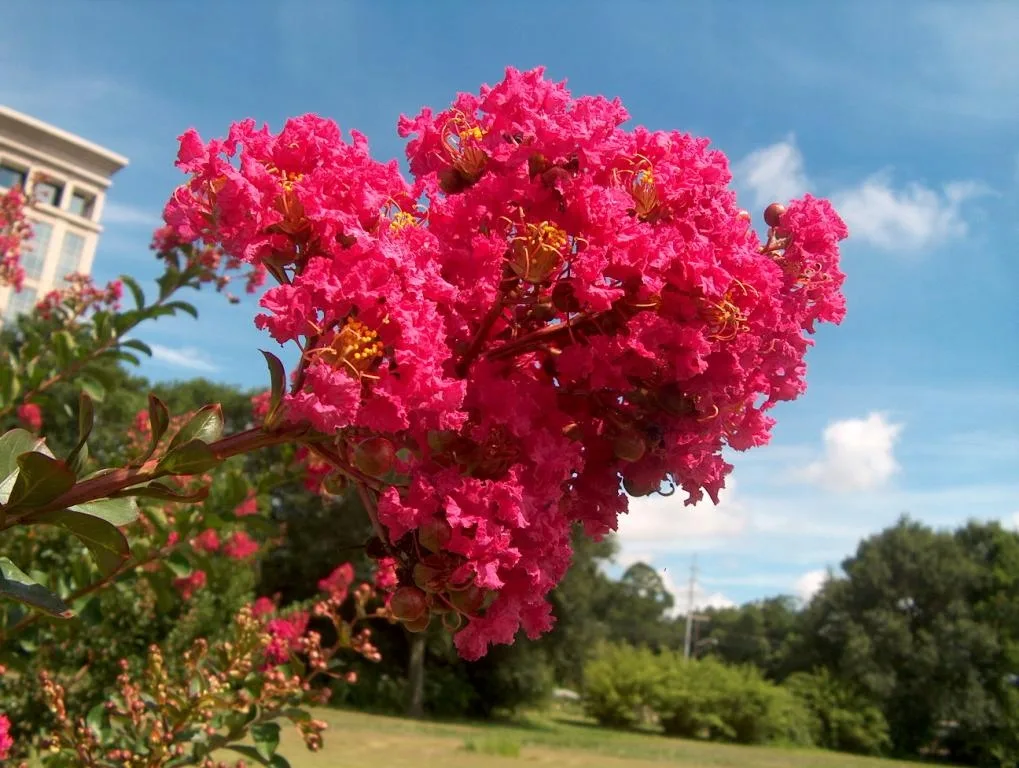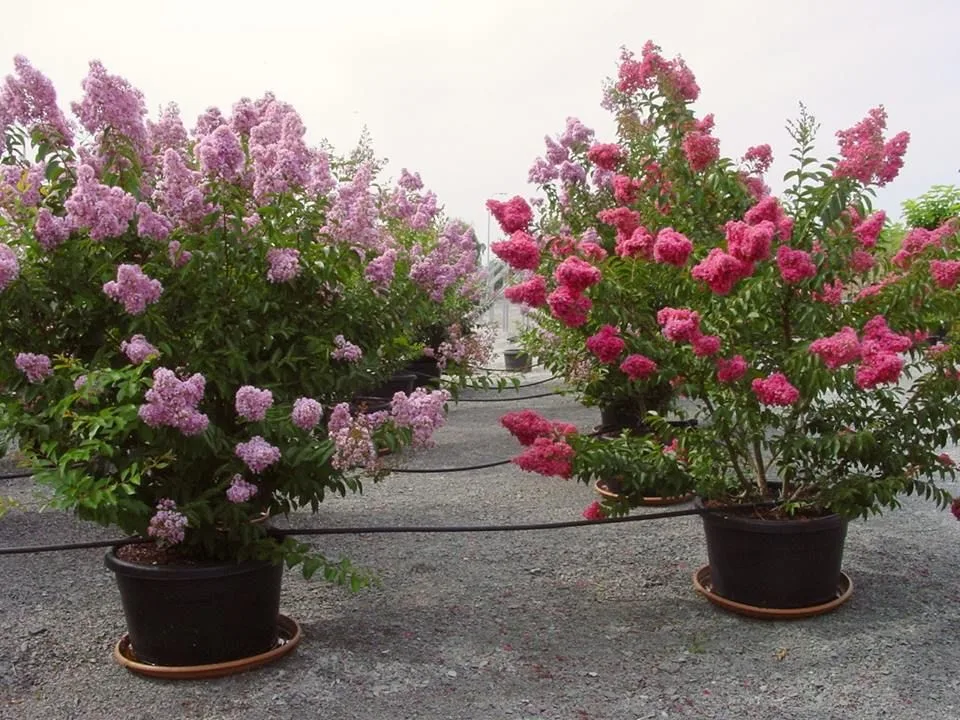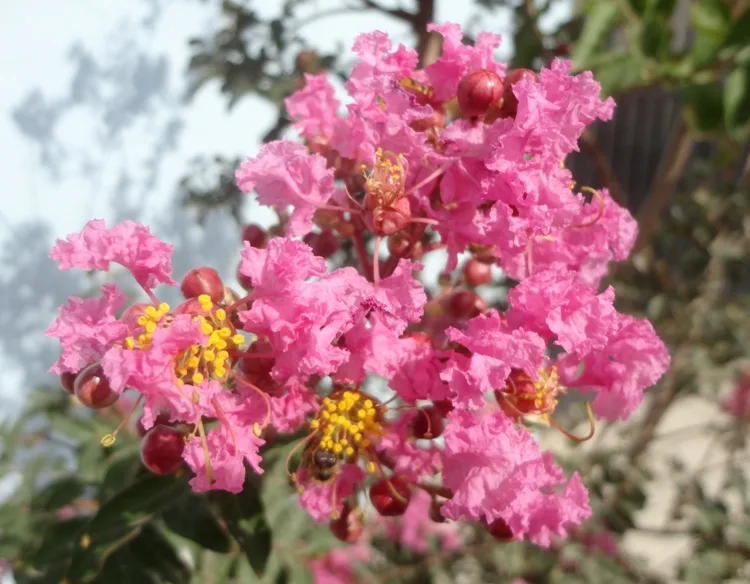índice
Introduction
Crepe Myrtle, scientifically known as Lagerstroemia indica, is a charming plant that wins admirers with its exuberant inflorescences. Originally from Asia, this deciduous species is widely cultivated for its beauty and resistance. Commonly called “Crepe Myrtle”, this plant stands out for its vibrant flowers that appear in summer, creating a spectacle of colors in the garden.
Meaning of Crepe Myrtle
In addition to its aesthetic beauty, Crepe Myrtlehas deep symbolic meanings in various cultures. Commonly associated with prosperity and longevity, this plant has become a symbol of continuous growth and endurance. Its exuberant flowering also represents renewal and the celebration of life. Knowing the meaning behind Crepe Myrtleadds an extra layer of appreciation to this magnificent plant, connecting us to the richness of nature and its timeless symbolism.
| Common Name | Crepe Myrtle |
| Botanical Name | Lagerstroemia indica |
| Family | Lythraceae |
| Plant Type | Shrub or small tree |
| Adult Size | Varies according to variety, usually medium to large |
| Sun exposure | Full sun |
| Soil type | Well-drained, rich in organic matter |
| soil pH | Slightly acidic to neutral (6.0 to 7.5) |
| Flowering Season | Summer |
| Flower color | Varies between shades of pink, purple, white and red |
| Native Area | Asia (mainly China, India, Japan, Korea) |
| Toxicity | It is not considered toxic to humans or animals, but it is always a good idea to avoid direct consumption |

How to Care for Crepe Myrtle (Lagerstroemia indica)
Crepe Myrtle, also known as Lagerstroemia indica, is a lovely plant, and caring for it can be a rewarding experience. Here are some essential tips to ensure that your Crepe Myrtleblooms and thrives:
Light
For exuberant flowering, Crepe Myrtle needs full sun exposure. Make sure you place it in a spot where it receives direct sunlight for at least six hours a day.
Soil
The soil is crucial for Crepe Myrtle’s healthy development. Opt for well-drained soil rich in organic matter. This will provide a solid base for root growth and help with the proper absorption of nutrients.
Water
Water your Crepe Myrtle consistently, keeping the soil moist but not soggy. Avoid excessive water accumulation, as this can lead to root problems.
Temperature and humidity
This plant thrives in warm climates. Make sure it is protected from frost, as it is sensitive to extreme temperatures. Crepe Myrtle appreciates moderate humidity, so spray the leaves with water during dry periods.
Fertilizing
Fertilize your Crepe Myrtle during the growing season with a balanced fertilizer. This will ensure that it receives the nutrients it needs to flower healthily.
By following these simple guidelines, you’ll be well on your way to enjoying a lush, vibrant Crepe Myrtle in your garden. Remember to observe its specific needs and adjust care as necessary.
Types of Crepe Myrtle (Lagerstroemia indica)
When it comes to the lovely Crepe Myrtle, there are several varieties available for growers and plant lovers to explore. Here’s a list of some notable types:
Pink Crepe Myrtle (Lagerstroemia indica ‘Pink)
This variety displays flowers in soft shades of pink, providing a romantic touch to the garden. It is generally medium-sized, making it a popular choice for landscaping.
White Crepe Myrtle (Lagerstroemia indica ‘Alba’)
The elegance of the White Crepe Myrtle is undeniable. Itsbright white flowers contrast beautifully with the dark green of the leaves, creating a classic and timeless look.
Purple Crepe Myrtle (Lagerstroemia indica ‘Purple’)
Purple Crepe Myrtle is known for its flowers in vibrant shades of purple. A vibrant option for adding a splash of color to your garden during the flowering season.
Red Crepe Myrtle (Lagerstroemia indica ‘Red’)
For those looking for a bold statement, Red Crepe Myrtle is the ideal choice. Its intense red flowers add warmth and vitality to the environment.
Dwarf Crepe Myrtle (Lagerstroemia indica ‘Dwarf’)
If space is limited, the Dwarf Crepe Myrtle is an excellent choice. While retaining its beauty and elegance, this variety is perfect for smaller gardens or even for growing in pots.
By choosing the type of Crepe Myrtle that best suits your taste and available space, you’ll add a unique and charming note to your garden. Explore these varieties and discover the diversity that Crepe Myrtle can offer.

How to Make Crepe Myrtle Cuttings
- Healthy Choice: Select a healthy branch for the seedling. Opt for a young, robust segment to increase the chances of success.
- Cut Carefully: Use sharp pruning shears to cut a segment about 15 cm long. Make sure to cut below a node, where new roots will develop.
- RemoveLower Leaves: Remove the leaves from the bottom of the segment, leaving only a few at the top to maintain photosynthesis.
- Hormone Treatment: Apply a rooting hormone to the cut end to stimulate root development. Follow the instructions on the product.
- Planting in Suitable Substrate: Plant the seedling in a well-drained substrate, keeping the soil moist but not soggy.
How to plant Crepe Myrtle
- Site selection: Choose a sunny spot with soil rich in organic matter. Make sure there is adequate space for the Crepe Myrtle to grow.
- Soil Preparation: Prepare the soil by adding organic compost to improve structure and fertility. Make sure the soil is well-drained.
- Planting: Dig a hole slightly larger than the seedling’s root ball. Position the seedling, filling the space around it with soil.
- Initial watering: After planting, water well to establish the seedling. Keep watering regularly until the plant is established.
By following these steps, you’ll be well on your way to growing a healthy and vibrant Crepe Myrtle. Remember to adjust the care as necessary and enjoy the lush blooms of this enchanting plant.

Most common pests and diseases
- Mites: Small mites can cause yellowing of the leaves. Control with natural acaricides or insecticidal soap.
- Mealybugs: Sucking insects that appear as white spots. Remove by hand or use specific insecticides.
- Fungus: Excessive humidity can lead to the development of fungus. Keep the plant dry and apply fungicides if necessary.
- Caterpillars: They can feed on the leaves. Control by hand or use organic pesticides.
Common Problems and Their Solutions
- Yellowing of the leaves:
- Cause: Can be a lack of nutrients or excess water.
- Solution: Fertilize properly and adjust watering.
- Sudden wilting:
- Cause: Could be lack of water or fungal attack.
- Solution: Keep watering regularly and apply fungicides if necessary.
- Leaf spots:
- Cause: Can be the result of fungi or pests.
- Solution: Apply fungicides and control pests as necessary.
- Flowers that don’t develop:
- Cause: It could be a lack of sunlight or nutrients.
- Solution: Move the plant to a sunnier spot and fertilize as recommended.
By paying attention to these signs and implementing the suggested solutions, you will ensure that your Crepe Myrtle remains healthy and lush. Remember to monitor regularly and act proactively to keep your plant at its best.
Curiosities and myths
Crepe Myrtle, also known as Lagerstroemia indica, is a plant rich in history and meaning. Let’s dive into some fascinating curiosities and debunk some myths associated with this beautiful species:
Curiosities
- Origin of the name: The name “Lagerstroemia” is a tribute to the Swedish botanist Magnus von Lagerström, who made a significant contribution to plant taxonomy.
- Cultural significance: In Eastern culture, Crepe Myrtle is often associated with longevity and prosperity. It is often planted in gardens as a symbol of good fortune.
- Color Varieties: In addition to the traditional pink and purple flowers, there are varieties of Crepe Myrtle with white, red and even orange flowers.
- Long-lasting flowers: Crepe Myrtle flowers are known for their durability. They can remain in bloom for several weeks, adding a vibrant touch to the garden.
Myths Debunked
- Crepe Myrtle Attracts Snakes: This is a common myth, but there is no scientific evidence to prove that Crepe Myrtle attracts snakes. It is a safe ornamental plant to have in the garden.
- Crepe Myrtle is Toxic: Contrary to the myth, Crepe Myrtle is not considered toxic to humans or pets. However, it is always advisable to avoid direct ingestion.
- Needs Full Sun: Although Crepe Myrtle prefers full sunlight, it can also thrive in places with partial shade. It is not exclusively a full-sun plant.
By exploring these curiosities and debunking some misconceptions, the experience of growing Crepe Myrtle becomes even more enriching. Learning about the history and myths associated with this plant brings a new layer of appreciation to its presence in the garden.

Conclusion
In summary, Crepe Myrtle, or Lagerstroemia indica, is a stunning addition to the world of gardening, offering not only visual beauty, but also a variety of cultural meanings. By learning about essential care, from planting to pest and disease management, you can ensure that your Crepe Myrtle blooms lushly in your garden. The diversity of types, colors and myths surrounding this plant adds a fascinating dimension to the experience of growing it.
Always remember to adjust the care according to your Crepe Myrtle’s specific needs and thus enjoy a journey full of color, symbolism and, of course, the satisfaction of seeing this unique plant thrive in your own green space. By investing time and attention, you will not only grow a healthy Crepe Myrtle, but also reap the rewards of a vibrant garden full of life.
Frequently Asked Questions
What is the Crepe Myrtle plant?
Crepe Myrtle, scientifically known as Lagerstroemia indica, is an ornamental plant with lush flowers, belonging to the Lythraceae family. Commonly called “Crepe Myrtle,” it is prized for its colorful inflorescences and is a popular choice in landscaping.
How tall is the Crepe Myrtle?
The height of the Crepe Myrtle varies depending on the variety and growing conditions. However, on average, this plant can reach heights of 3 to 5 meters when fully grown. Some dwarf varieties are also available, ideal for smaller spaces or growing in pots.
How long does Crepe Myrtle bloom?
Crepe Myrtle is known for its long flowering period, providing a spectacle of color in the garden. Flowering times can vary, but in general Crepe Myrtle blooms during the warmer months, usually in spring and summer. Flowering can last for several weeks, filling the room with its beauty.







